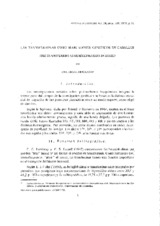Mostrar el registro sencillo del ítem
Las transferrinas como marcadores genéticos en caballos
| dc.contributor.author | Ariza Arellano, A. | |
| dc.date.accessioned | 2010-04-20T10:56:23Z | |
| dc.date.available | 2010-04-20T10:56:23Z | |
| dc.date.issued | 1979 | |
| dc.identifier.issn | 1885-4494 | |
| dc.identifier.uri | http://hdl.handle.net/10396/3053 | |
| dc.description.abstract | 1. Have been analysed 169 samples of horses blood, taken from the 7th Deposit of Studs and from Cuevas de Artaza of Cordoba. The horses belonged to English, Spanish, Arab and Bretons breeds and their various cross-breeds. 2. We have used the electrophoretic method on starch-gel horizontal, described by Kristjansson in 1963 and modified by Efremov and Braend in 19.64, in order to obtein the transferrins bands from serum. 3. Our nomenclature is the same given by braend and Stormont in 1964. 4. Of the 21 possible phenotype we have found 15; three honrocigotes (DD, FF and RR) and the rest heterocigotes (DF, DH, DM, DO, DR, FH, FM, F0, FR, JIM, HO and HR). 5. The most common phenotype in all races has been the DF, with 33,73 p. 100 of the horses, then FF with a 20,71 p. 100. The less frequent phenotype found has been the DR which is only present in one horse of Spain breed. The HM, HR and RR phenotypes were observed in 1,18 p. 100 of the cases. 6. It is possible the differentiation between light populations and heavy populations by the higher frequency of allele TO) and TfF in the light ones and of allele TfH in the heavy ones. 7. Finally, we consider that transferrins, together with other polymorphisms, play and unquestionable part in animal identification and also in cases of doubtful . paternity. | en |
| dc.description.abstract | 1. Se han analizado 169 muestras de sangre procedentes de caballos del 7° Deposito de Sementales y de las Cuevas de la Condesa de Artaza (Córdoba), pertenecientes a las razas P. S., árabe, española, caballos bretones y algunos de sus cruces. 2. Para la obtención de las bandas de transferrina a partir del suero, se ha empleado el método electroforético sobre gel de almidón horizontal, descrito por Kristjansson (1963) y modificado por Efremov y Braend (1964). 3. Nuestra nomenclatura se ajusta a la dada por Braend y Stormont en 1964. 4. De los 21 fenotipos posibles hemos encontrado 15, de los cuales tres son homocigotos (DD, FF y RR) y dote heterocigotos (DF, DH, DM, DO, DR, FH, FM, FO, FR, HM, HO, HR). 5. El fenotipo más común en todas las razas ha sido el DF, que se presentó en el 33,73 p. 100 de los caballos investigados, seguido del fenotipo FF que lo fue en el 20,71 p. 100 de ellos. El fenotipo menos frecuente ha sido el DR, que solo se observó en un caballo español; y los fenotipos HM, HR y RR, que se detectaron en el 1,18 p. 100 de los casos. 6. Es posible la diferenciación entre poblaciones ligeras y pesadas por la mayor frecuencia de los alelos TfD y TfF en los ligeros, y del alelo Tfl en los pesados. 7. Atribuimos a las transferrinas, junto con otros polimorfismos, un papel indiscutible en identificación animal, así como en la resolución de casos de paternidad dudosa. | es_ES |
| dc.format.mimetype | application/pdf | es_ES |
| dc.language.iso | spa | es_ES |
| dc.publisher | Universidad de Córdoba, Servicio de Publicaciones | es_ES |
| dc.rights | https://creativecommons.org/licenses/by-nc-nd/4.0/ | es_ES |
| dc.source | Archivos de zootecnia 28 (109), 51-58 (1979) | es_ES |
| dc.subject | Équidos | es_ES |
| dc.subject | Marcadores genéticos | es_ES |
| dc.subject | Transferrinas | es_ES |
| dc.subject | Caballos | es_ES |
| dc.title | Las transferrinas como marcadores genéticos en caballos | es_ES |
| dc.title.alternative | The transferrins as genetics marker in horse | en |
| dc.type | info:eu-repo/semantics/article | es_ES |
| dc.relation.publisherversion | http://www.uco.es/organiza/servicios/publica/az/az.htm | es_ES |
| dc.rights.accessRights | info:eu-repo/semantics/openAccess | es_ES |

